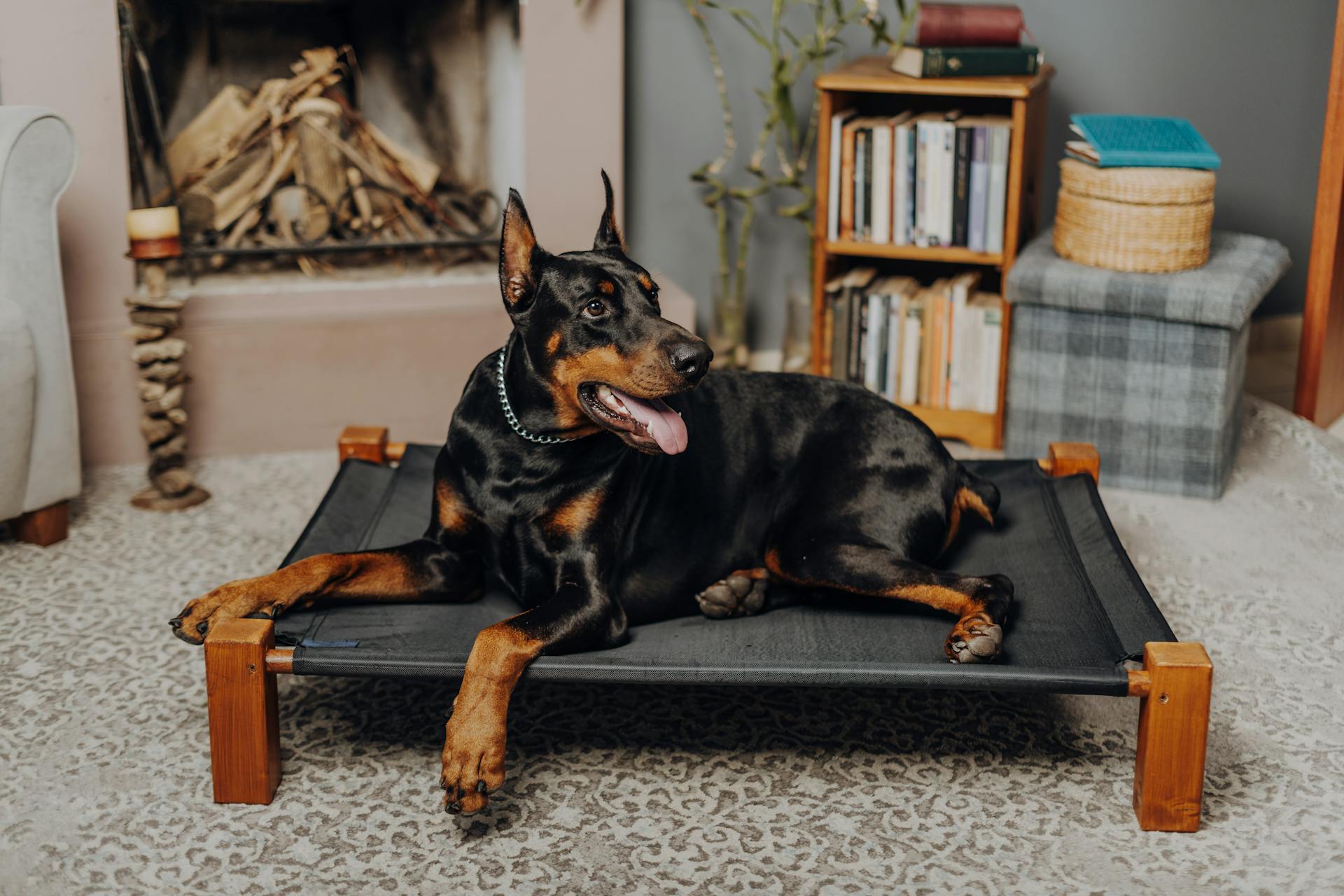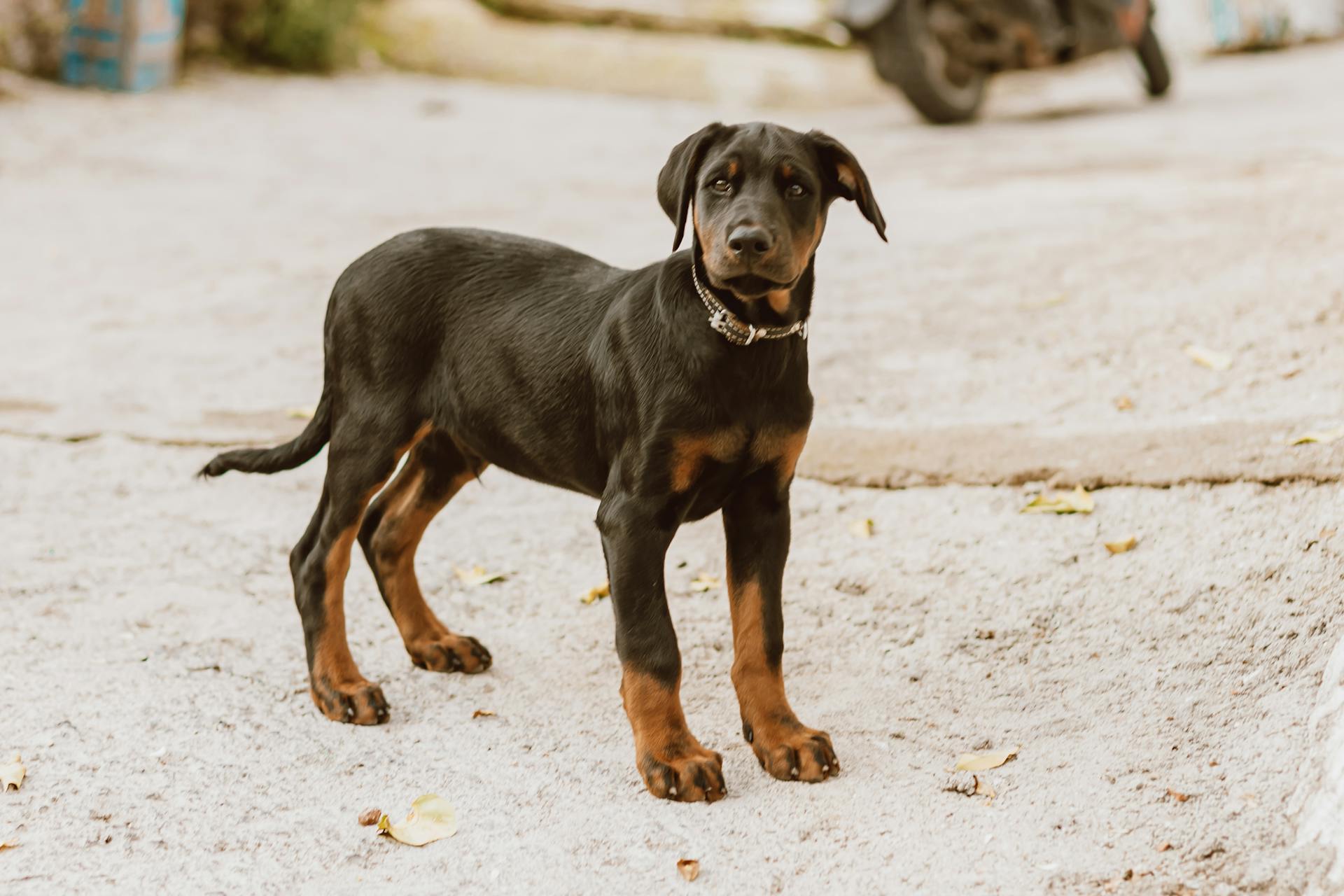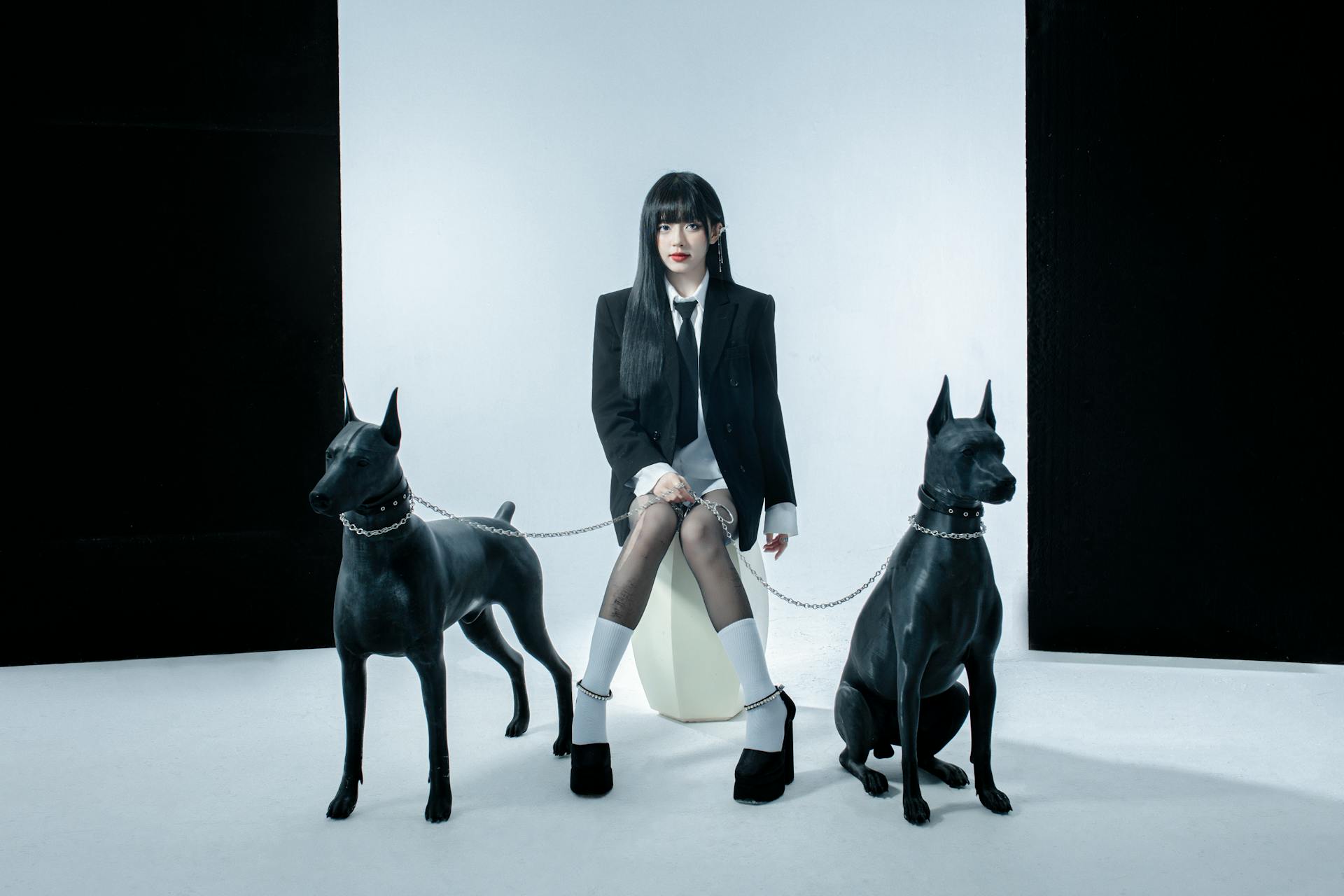
Doberman Pinschers are known for their sleek appearance and loyal nature, but they can also exhibit snarling behavior that's often misunderstood.
Doberman Pinschers snarl when they feel threatened or scared, which is a natural defense mechanism inherited from their ancestors.
A Doberman Pinscher's snarl can be a sign of resource guarding, as they may feel the need to protect their food, toys, or space from perceived threats.
In fact, studies have shown that Doberman Pinschers are more likely to exhibit snarling behavior when they're defending their food than when they're in other situations.
Their snarl can also be a sign of anxiety or stress, which can be triggered by loud noises, new environments, or even separation from their owners.
Debunking Aggression Myths
Doberman Pinschers are not inherently aggressive, a common myth that's been debunked by experts. They're a loyal and intelligent breed that can make great family pets.
Their reputation for being strong and protective led to misconceptions about their temperament, but responsible breeding practices and proper socialization can help ensure they grow up to be well-balanced and friendly pets.
Dobermans were originally bred in Germany in the late 19th century to be loyal, intelligent, and versatile working dogs.
Proper breeding, socialization, and training play a significant role in their temperament, not their genetics or breed alone.
Dobermans can be protective, but this doesn't mean they're automatically aggressive towards humans without reason. With proper socialization and training, they can be friendly and well-behaved.
Dobermans are loyal dogs that form strong bonds with their families, and instances of a Doberman turning on their owner are rare and often the result of neglect, abuse, or improper training.
Dobermans respond best to positive reinforcement training methods, not harsh or aggressive techniques that can harm their sensitive nature and lead to fear-based aggression.
Readers also liked: Obedience Training for Doberman Pinscher
Factors Influencing Aggression
Genetics play a significant role in temperament, and choosing a reputable breeder who focuses on producing well-tempered dogs is essential.
Responsible breeders take into account not just physical traits but also temperament when selecting breeding pairs, which helps ensure that the offspring inherit the desired qualities and are less likely to exhibit aggression.
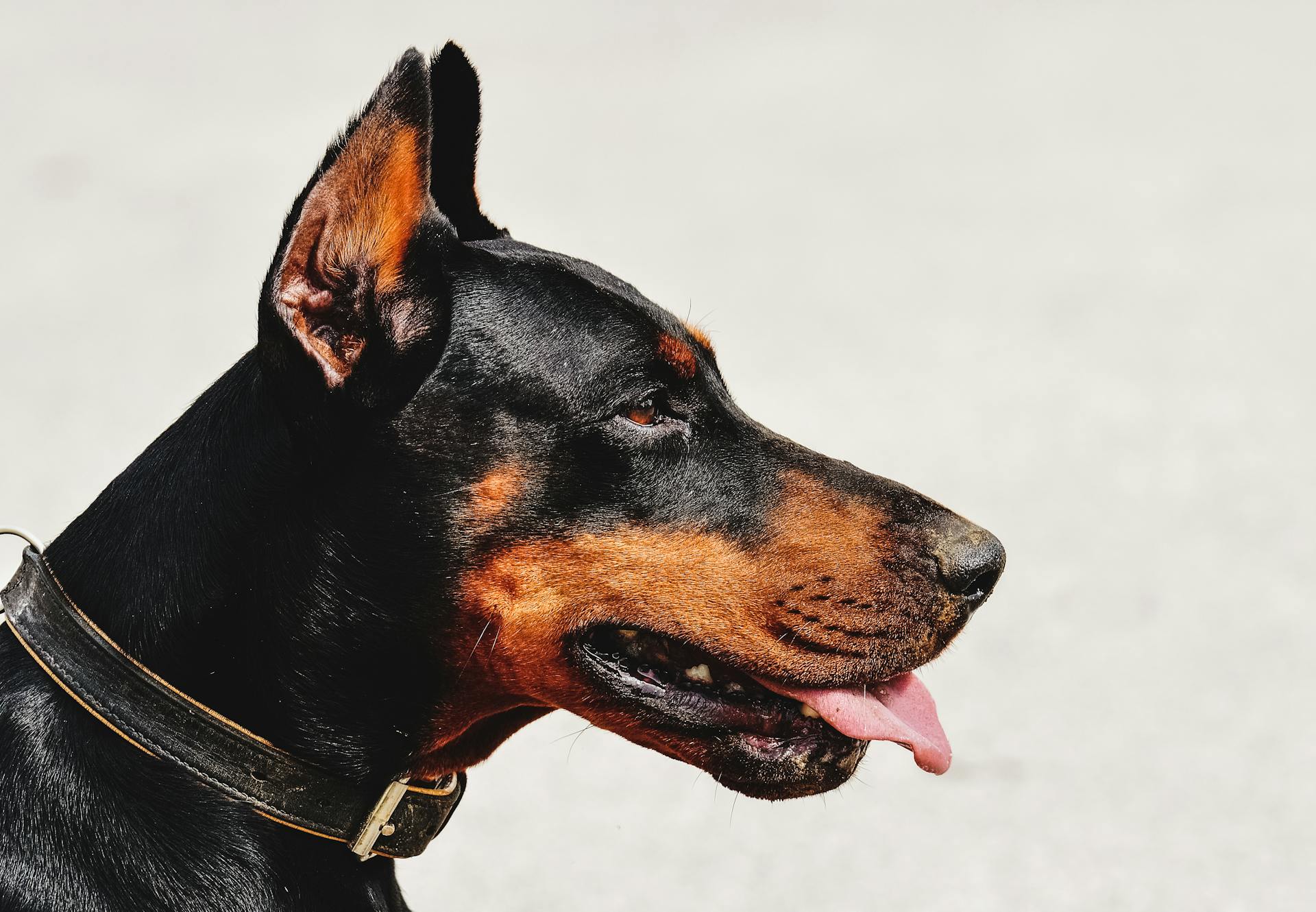
Early and ongoing socialization is crucial in shaping a Doberman's behavior, and exposing them to various people, animals, environments, and situations from a young age helps them develop confidence and adaptability.
Positive reinforcement techniques such as reward-based training can be highly effective in teaching Dobermans desired behaviors and preventing aggression.
Consistency, patience, and clear communication are key when training a Doberman, and establishing yourself as the pack leader and setting clear boundaries is vital in preventing potential behavioral issues.
Here are some key factors that can influence aggression in Dobermans:
Preventing and Addressing Aggression
Debunking the myth that Dobermans are inherently aggressive is crucial. Dobermans are not born aggressive, but their behavior is influenced by factors like genetics, socialization, and training.
Responsible breeding practices can help ensure that Dobermans grow up to be well-balanced and friendly pets. A reputable breeder will consider not just physical traits but also temperament when selecting breeding pairs.
Discover more: Doberman Pinscher Aggressive
Socialization is a vital factor in shaping a Doberman's behavior. Exposing Dobermans to various people, animals, environments, and situations from a young age helps them develop confidence and adaptability.
Positive reinforcement techniques like reward-based training can be highly effective in teaching Dobermans desired behaviors and preventing aggression. Consistency, patience, and clear communication are key when training a Doberman.
To prevent aggression in Dobermans, establish yourself as the pack leader and set clear boundaries. This will help prevent any potential behavioral issues.
If you notice any concerning behavior in your Doberman, seek professional help from a qualified dog trainer or behaviorist experienced in working with Dobermans.
Here are some tips for recognizing and addressing aggressive behavior in Dobermans:
- Look for signs of aggression such as growling, snapping, biting, or displaying dominant behaviors.
- If you notice any of these signs, seek professional help promptly.
- A professional can assess the situation, identify potential triggers, and develop a behavior modification plan tailored to your Doberman's specific needs.
By following these tips and being proactive, you can help prevent aggression in your Doberman and ensure a happy and healthy relationship with your pet.
Understanding Aggressive Behavior
Doberman Pinschers are often misunderstood as aggressive dogs, but the truth is, their behavior is influenced by various factors such as genetics, socialization, and training. Genetics play a significant role in temperament, and choosing a reputable breeder who focuses on producing well-tempered dogs is essential.
Responsible breeders take into account not just physical traits but also temperament when selecting breeding pairs, which helps ensure that the offspring inherit the desired qualities and are less likely to exhibit aggression. Socialization is another crucial factor in shaping a Doberman's behavior.
Exposing Dobermans to various people, animals, environments, and situations from a young age helps them develop confidence and adaptability. Positive reinforcement techniques such as reward-based training can be highly effective in teaching them desired behaviors and preventing aggression.
Consistency, patience, and clear communication are key when training a Doberman. It's essential to establish yourself as the pack leader and set clear boundaries to prevent any potential behavioral issues. A well-socialized and well-trained Doberman is less likely to snarl or exhibit aggressive behavior.
Here are some common signs of aggression in Dobermans:
- Growling
- Snapping
- Biting
- Displaying dominant behaviors
If you notice any concerning behavior, it's essential to seek professional help from a qualified dog trainer or behaviorist experienced in working with Dobermans. A professional can assess the situation, identify potential triggers, and develop a behavior modification plan tailored to your Doberman's specific needs.
Defensive and Offensive Threats
When you notice a Doberman Pinscher snarling, it's essential to recognize the underlying threat posture. A defensive threat posture is quite intimidating, with the dog crouched low, head down, and showing a lot of teeth while growling.
This posture is a clear indication that the dog feels threatened and cornered, making it the most dangerous to witness. The dog needs to be removed from the situation and allowed to relax.
A Doberman in a defensive threat posture often desperately needs socialization.
Defensive Threat
A Doberman in a defensive threat posture is a sight to behold, but it's also a clear warning sign that the dog feels cornered and fearful. This posture is characterized by the dog being crouched low with its head down, showing a lot of teeth and growling.
This is the most intimidating and dangerous posture to witness, as the dog feels it has no choice but to lash out and cause harm. Correction should never be administered to a Doberman in this position.
A Doberman that shows this posture often desperately needs to be socialized, as it's a sign that the dog is struggling with feelings of fear and insecurity.
Offensive Threat
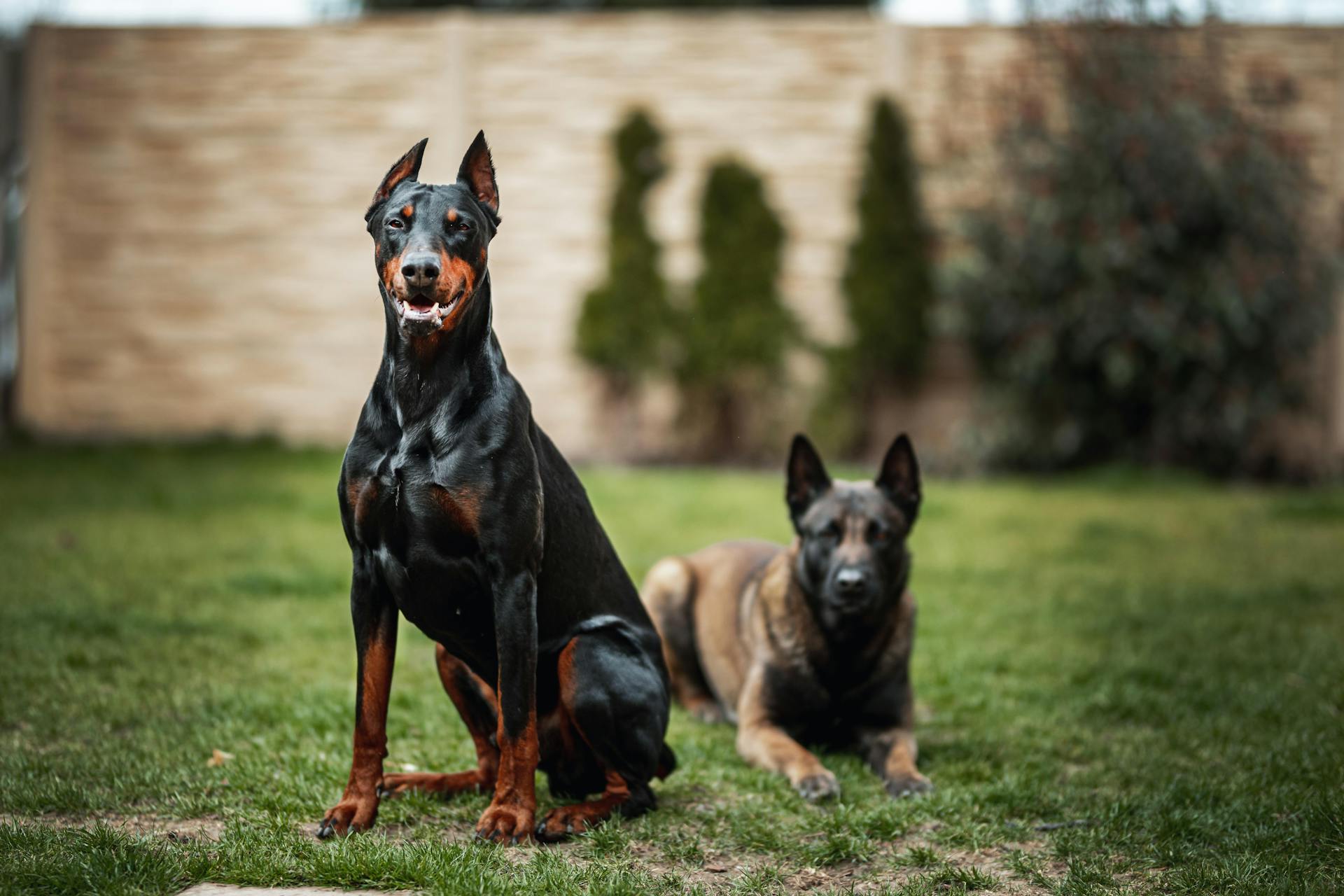
The offensive threat posture is a serious warning sign that your Doberman Pinscher is perceiving something as a threat. This posture is characterized by the dog standing very tall with ears forward, lips pulled back, and teeth displayed.
The Doberman's hair will stand on edge, making it clear that he's on high alert. It's a sign that he's ready to defend himself or his family.
If you're training a Doberman, it's essential to handle them carefully when they display this posture. They can be a powerful breed, and their instincts may take over if they feel threatened.
Someone should never dare approach you with the dog displaying this posture, as it's a clear warning that they're not to be trifled with.
Conclusion and Stress Factors
Doberman Pinschers are not inherently aggressive dogs, their behavior is shaped by factors such as genetics, socialization, and training.
Responsible breeding, early and ongoing socialization, and positive reinforcement training play a crucial role in preventing aggression and shaping a well-behaved Doberman.
It's essential to recognize the stress posture in your Doberman, characterized by back ears, dilated pupils, and a lowered body, often accompanied by heavy panting.
By being aware of these stress factors, you can take steps to address them and create a more positive training environment for your Doberman.
Readers also liked: Doberman Guard Dog Training
Conclusion
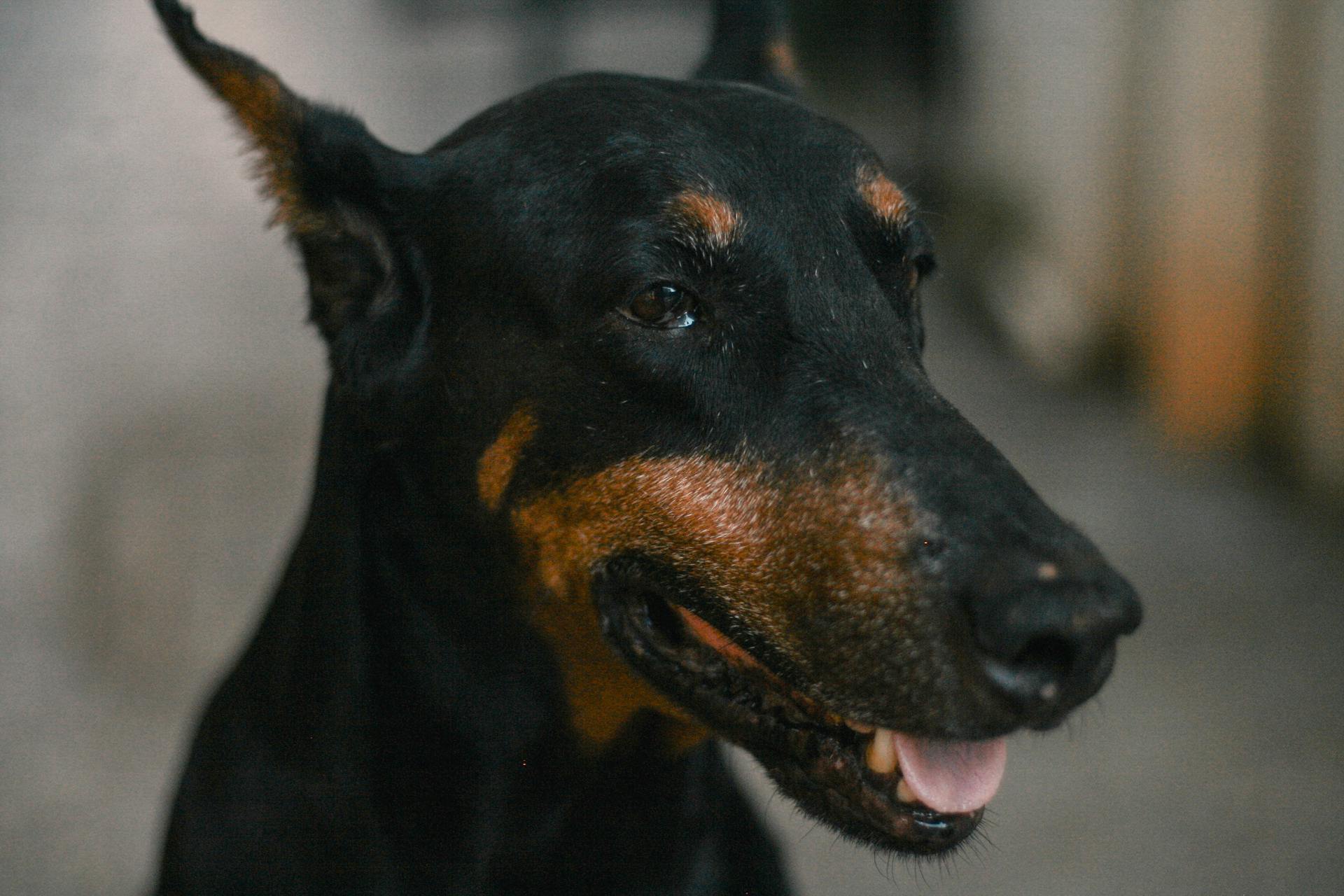
As we wrap up our discussion on stress factors, it's essential to remember that genetics, socialization, and training play a crucial role in shaping a dog's behavior.
Responsible breeding is key, as it helps prevent aggression and promotes a well-behaved dog.
Early and ongoing socialization is vital, as it helps dogs interact with their environment and people in a positive way.
Positive reinforcement training is also essential, as it encourages good behavior and discourages bad behavior.
By being a responsible owner and ambassador for the breed, you can help break stereotypes and showcase the true nature of a dog, like the Doberman Pinscher, as a loyal, intelligent, and loving companion.
Investing time and effort into proper socialization and training can make all the difference in your dog's behavior and your relationship with them.
If you're considering bringing a dog into your life, choose a reputable breeder and seek professional help if needed to ensure a smooth and happy relationship.
Stress
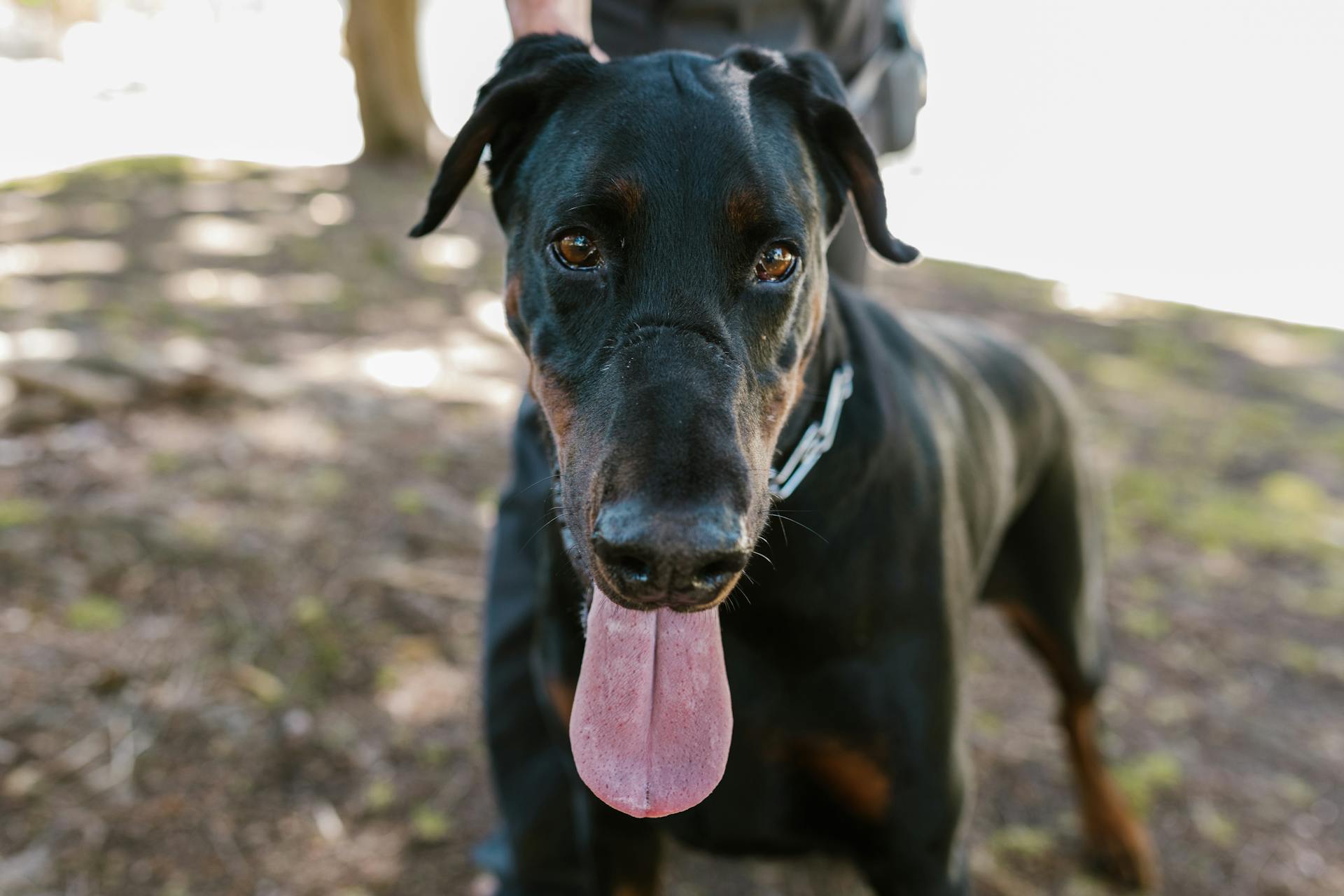
Stress is a crucial factor to consider when training Doberman Pinschers. Genetics play a role in temperament, and a reputable breeder who focuses on producing well-tempered dogs can help minimize the likelihood of aggression.
Socialization is key in shaping a Doberman's behavior, and early and ongoing socialization can prevent aggression. A well-socialized Doberman is more likely to be confident and adaptable.
Dobermans need regular breaks to avoid stress. The stress posture is a clear indicator of physical pain, mental stress, or serious illness, and it's characterized by ears back, dilated pupils, a down tail, and heavy panting.
Positive reinforcement techniques can help reduce stress and prevent aggression. Consistency, patience, and clear communication are essential when training a Doberman.
Discover more: Doberman Dog Aggression
Pinscher
The Pinscher is a breed of dog that's often associated with the Doberman Pinscher. It originated in Germany in the 19th century.
The Pinscher's ancestors were used for hunting and guarding, which is why the Doberman Pinscher inherited their strong protective instincts.
The Pinscher's name comes from the German word "pinscher", meaning "to bite." This is fitting, given the breed's history as a ratcatcher.
The Pinscher's short coat and athletic build made them well-suited for their original purpose. They're also intelligent and energetic, which makes them a great match for active owners.
The Pinscher's legacy lives on in the Doberman Pinscher's physique and temperament.
Sources
- https://blog.tryfi.com/are-doberman-pinscher-aggressive/
- https://www.askthedogguy.com/aggressive-doberman-problem/
- https://www.growlsnarlsnap.com/most-aggressive-dog-breeds/
- https://petexpertise.com/blogs/news/dog-training-and-emotional-behavior
- https://medium.com/@williamjosh/learn-body-language-to-train-doberman-pinschers-1c7c7b7f59d1
Featured Images: pexels.com
